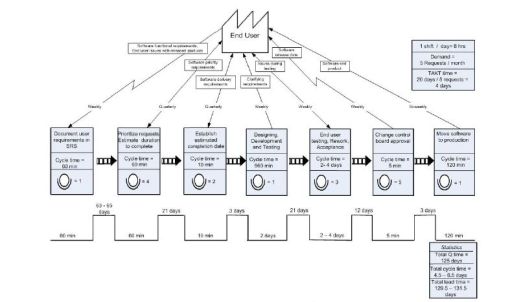 The fun part about actually seeing flow is just that … we can see it, touch it, interact with it and do something about it to improve it. This is easier in a factory, where the concept of applying the principles behind flow were first written about.
The fun part about actually seeing flow is just that … we can see it, touch it, interact with it and do something about it to improve it. This is easier in a factory, where the concept of applying the principles behind flow were first written about.
As a “lean leader” in an IT organization, I had the opportunity to consult with a local manufacture of lift equipment as part of my lean leadership training. This experience was invaluable to me (like one of those MasterCard priceless moments commercials). I got to see immediate opportunities by visually inspecting what was happening on the factory floor and work with my fellow consultants on improving the flow for the hydraulic lift sub-assembly. Essentially we were leading a week long Kaizen for this area of the floor. The fun part was working with our ultimate consultant, one of the Japanese Lean sensei, interpreter and all.
I could have stopped there and chalked it up to a good experience, but that would have been a waste … instead, being ever curious, I started visualizing the entire lift device (see the picture) as my project and all the pieces and sub-assemblies as my stories and features.
Each sub-assembly delivers a specific portion of functionality to the whole so that bit by bit the thing is delivered.
This is what we do in IT projects (and in technology product companies). We define our goal/vision (the scissor lift), and we build it within increments of parts that flow within sub-assemblies (tasks/stories/features inside iterations). But how do we deliver it?
The part to focus on is the flow … the piece … the part. (some folks use a relay race metaphor…focus on the baton). The manufacturer monitors and works hard to achieve flow of the scissor lift and the flow of the sub-assemblies that add value to the scissor lift becoming complete. The manufacturer in this case has very specific timings to complete the sub-assemblies so they are ready for the scissor lift at the appropriate time (in this case it was a little over 5 minutes if I remember correctly) … when this happens, the place hums .. it flows … everyone in sync … and we can SEE it (it is a thing of beauty from a geeky process point of view).
We in IT measure the flow of requirements and work towards building our technology solution bit by bit … at least I would hope we do. Flow is what the entire business cares passionately about … flow of information, flow of business value.
When we care and focus on flow, we naturally start looking at those requirements as very valuable whole pieces … we don’t have to wait to deliver an entire technology solution to the business in 1.5 years … we can deliver something in weeks to a couple of months … why wait? We can deliver that portion of the shopping cart experience now … we can deliver the single sign on capability now … we can deliver the <add your feature here> now. Why do we think we have to package a bunch of stuff up? I guarantee you the entire business would have so much more trust of IT if we delivered in short cycles … it is about responsiveness. The business cannot afford to not respond to the world, why do we make them wait on the technology to do so? We rob the business (of which we in IT are included) of revenue now when we have to wait on technology.
Yes, sometimes we wait to initiate projects based on priority and the capacity of our IT system. However when we commit to a delivery as we have capacity to do so, why do we then do so in a fashion that is slow to respond?
Think Flow. Think Small. Deliver. Respond.
Reap the rewards of doing so.
Next time … based on search criteria to find and read this blog, I see people are very interested in flow … specifically value stream mapping … so perhaps something on VSM and then responsiveness.
 Following up from my last post a few weeks ago (
Following up from my last post a few weeks ago (
 I am finishing up consulting with a couple of information technology team PMs in a local company and completed my recommendations report. I am communicating here what I communicated to this company. The interesting thing about this company is how they have segmented themselves into specialties. These specialties include design, information architecture, functional analyst, front-end development, back-end development, testing, and copy (for website features). Note: I am not passing judgement on this team configuration … in this case, the organization recognizes that people have passion around areas of solution delivery vs. creating generalists.
I am finishing up consulting with a couple of information technology team PMs in a local company and completed my recommendations report. I am communicating here what I communicated to this company. The interesting thing about this company is how they have segmented themselves into specialties. These specialties include design, information architecture, functional analyst, front-end development, back-end development, testing, and copy (for website features). Note: I am not passing judgement on this team configuration … in this case, the organization recognizes that people have passion around areas of solution delivery vs. creating generalists.
